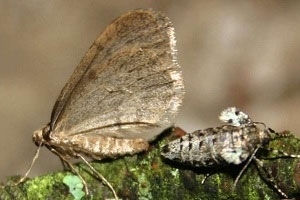Winter moth (Operophtera brumata)
 You might well think that there are no moths to be found during the winter, but actually there are some species flying around during these long nights, and the aptly named winter moth is one good example. Common to most of Britain, this moth occurs (as its English name suggests) from late autumn through to February. The male is a medium sized moth with a wingspan of up to 28mm across and has light to dark brown wings with a darker central forewing band and a brownish hind wing; so all in all, not the most spectacular insect that you will ever see!
You might well think that there are no moths to be found during the winter, but actually there are some species flying around during these long nights, and the aptly named winter moth is one good example. Common to most of Britain, this moth occurs (as its English name suggests) from late autumn through to February. The male is a medium sized moth with a wingspan of up to 28mm across and has light to dark brown wings with a darker central forewing band and a brownish hind wing; so all in all, not the most spectacular insect that you will ever see!
To dismiss this species because it doesn’t look that exciting would, however, leave you ignorant of its amazing life cycle. Surprisingly, the adult female winter moth is flightless, with only tiny useless wings. These females emerge from pupae within the soil during November to January and crawl up the trunks of trees to find a suitable vantage point. Once there, they give off pheromones that float off into the night air, hopefully attracting a passing male.
Once mated, the female lays her eggs up in the tree, choosing to hide them in cracks and crevices in the bark or even in developing buds, after which she dies. The caterpillars hatch in spring and feed voraciously on the buds, blossom and leaves of a wide range of trees, including fruit trees. For this reason, the winter moth is considered a pest that, if not controlled, can lead to serious losses for the growers of fruit.
Fruit farmers and gardeners have traditionally put a sticky grease band around the trunk of the fruit tree to act as a barrier, stopping the female from climbing up into the canopy to lay her eggs. Many garden centres stock ready-prepared strips for tying round the trunk or grease for direct application to the bark.
It is curious that the female winter moth has evolved to become wingless and to appear during the winter months. Obviously there are few flowering plants around at this time of the year and so there is little need to fly around looking for nectar, which in turn may mean that it is better to conserve energy for egg laying, rather than flight. But, to become flightless obviously severely restricts the ability to disperse, which could be a disaster in the longer term if conditions change.
The winter moth’s caterpillar has however developed the art of ballooning: hanging from a thin silk thread until the wind catches both the silk and tiny caterpillar, lifting them into the air and transporting the larvae to another nearby tree. Occasionally, people with moth traps set in the winter months, have also recorded adult males arriving to the light with a female attached during copulation, which may also act as another way to disperse – by piggy back!
The light green looper (meaning that they arch their back when moving) caterpillars grow quickly and reach about an inch long in early June, providing a wonderful meal for any bird with a hungry family to feed. Many birds, including the tit family, have been shown to time their broods to co-inside with this abundance of protein rich food. However, if global warming continues to start our spring season earlier and earlier, it may well be that the tit/caterpillar relationship gets out of kilter, potentially proving a disaster for the birds and maybe resulting in winter moths becoming much more of a serious pest in the future.
Those caterpillars which survive the bird predation climb back down the tree to pupate in the soil and start the cycle once again. So always remember not to ignore a species just because its appearance is rather dull, more often than not there is much more to it than meets the eye!
Peter Thompson
Advisory

Download Peter Thompson's essential 26-page book, featuring beautiful photography and detailed profiles of Britain's wildlife
Download FREE >